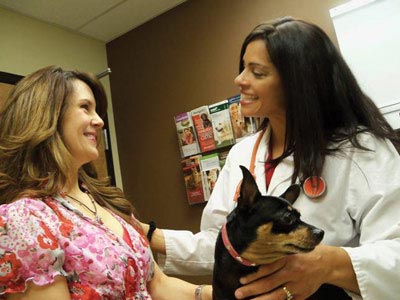Connection is object of cultural competency
 First, picture a pack of African wild dogs. Next, visualize a lone orangutan.
First, picture a pack of African wild dogs. Next, visualize a lone orangutan.
Which are veterinarians most like?
Dr. Jenifer Chatfield’s question was met with amusement at the Symposium on Cultural Competency, held July 21 during the AVMA Annual Convention in Chicago.
“African wild dogs are the most socially complex of all the canids, but you don’t necessarily see it unless you’re one of them,” said the zoo veterinarian, whereas orangutans, one of the least social of the great apes, are quite content living alone.
“We are part of a significantly complex profession. We must all interact well with each other in order to achieve great things for our patients and our clients, would you agree?” asked Dr. Chatfield, a member of the 2012-2013 class of AVMA Future Leaders, who presented the symposium.
The event dovetailed with the afternoon AVMA Symposium on Veterinary Diversity, the ninth and final one. In the future, diversity and cultural competency themes will be integrated into existing programming at the convention and other venues to benefit more AVMA members.
Zoetis sponsored the symposiums and has provided funding for the Future Leaders Program since its inception.
Cultural differences relate not only to geographic backgrounds but even to medical styles and cultures within veterinary schools, Dr. Chatfield noted. By engaging with other cultures, you will find “some piece you can take away that can help you become a better vet.”
The cultural competency symposium began with Future Leader Dr. William A. Hill’s presentation, “Connecting for More.” The concept of connection surfaced throughout the day.
Why is cultural competency important to veterinarians? Dr. Hill said, “I would submit that the demographics are changing. If veterinary medicine is to remain relevant and to serve all segments of the population, we must change.”
Cultural competency doesn’t require a mastery of the norms, values, and practices of all cultures, he said, but instead, recognition of one’s own biases, consciousness of cultural dynamics, and a willingness to adapt.
Dr. Jennafer Glaesemann, whose community around her Nebraska mixed animal practice is 96 percent Caucasian, grudgingly admitted she was a bit offended when her fellow Future Leaders decided on the cultural competency project. She wondered what was in it for her clinic and other practitioners in her area. She found out when, after presenting a cultural competency module for her clinic staff in April, the clinic gained 51 clients and increased revenue by 15 percent—by May.
“Clients as diverse as their pets” was her clinic’s theme in applying the module. Dr. Glaesemann said, “Our clinic sees everything from alpacas to snakes.”

Her clinic emphasizes the consistent offering of best medical practices to all clients, aided in great part, she said, by the AVMA/American Animal Hospital Association companion animal health care guidelines developed through the Partnership for Preventive Pet Health Care and supplemented by clinic standards Dr. Glaesemann developed.
The clinic adopted practical ideas from staff, from naming a bilingual team member as primary service liaison to updating the clinic website and Facebook page with more visuals. The staff continue to watch for subtle biases and unintended voice cues.

Florida clinic owner Dr. Ana D. Ortiz gave a lively talk about connecting with minority clients, particularly Hispanics like herself. At the same time, she and others noted that the Asian-American community is one with even more economic potential.
“For many years, we’ve concentrated on diversity as a problem. Today, I want to celebrate it as an asset,” Dr. Ortiz said. She said cultural competency enhances team quality, offers a better understanding of clientele—and makes practice more fun. Cultural connections through other local businesspeople and community events enhance one’s reputation and increase referrals, said Dr. Ortiz, whose practice area has 12 competing clinics.
Dr. Larry M. Kornegay, former AVMA president, gave an update on AVMA involvement in advancing diversity and cultural competency within the profession, as did Dr. Ted Cohn, former Executive Board chairman and 2013-2014 AVMA president-elect, in the afternoon diversity symposium.
Dr. Kornegay posed the question: Are you competent to practice in a multicultural, multilingual environment? “As a culturally competent veterinarian, you’d tailor the delivery of medical services in a fashion that would be understood by the client and result in the best possible outcome for the well-being of the animal,” he said.
Although veterinarians do not reflect the diversity of the U.S. population, Dr. Kornegay said veterinarians can embrace many things to make their practices more attractive to minorities.
Dr. Kornegay noted that some universities, such as Texas A&M, offer a certification program in cultural competency and Spanish communication.
He also highly recommended the book “Navigating Diversity and Inclusion in Veterinary Medicine,” edited by Lisa M. Greenhill; Kauline Cipriani Davis, PhD; Patricia M. Lowrie; and Dr. Sandra F. Amass. The book was launched this past March at the Iverson Bell Symposium.
Several speakers encouraged veterinarians to visit the U.S. Census Bureau website to check on race, gender, income, and household makeup within their region and become knowledgeable about demographics.
Dr. Evan M. Morse, diversity symposium moderator and co-organizer, said, “Increasingly, the faces of our clients are transforming into faces of color; faces of women; faces of individuals with disabilities; faces of gay, lesbian, bisexual, and transgender individuals; and faces of older workers.
“As the demographics in this country continue to shift, veterinary hospitals that have put compelling diversity initiatives in place will reap the benefits. Those benefits can be significant, from tapping emerging markets to attracting and retaining better talent to saving money to increasing profits and creativity.”
Presentations by Michael Dicks, PhD, director of the AVMA’s new Veterinary Economics Division, and Dr. Dan Thomson of Kansas State University illustrated the move toward integrating cultural competency into other programming. Addressing the role of diversity in veterinary workforce issues, Dr. Dicks presented workforce data that can help veterinarians better market their business.
“Understand the structure of the market and the demographics of your market, and develop a strategy for each segment of the market,” Dr. Dicks said.
Dr. Thomson spoke about how understanding cultures has increased compliance by clients with food animals. Collaborating with the American Association of Bovine Practitioners and Livestock Marketing Association, he developed an online training site, with modules in English and Spanish on animal husbandry, animal welfare, environmental stewardship, and food safety practices.
Dr. Cohn challenged practitioners to reach out to untapped client populations. “Diversity is not about lowering standards. It’s about providing opportunities,” he said.